Abstract
A broad profile of national standard race-walkers was obtained. Subjects were taller and had more body fat than competitive runners of comparable distance as found in the literature. Pulmonary function, blood pressure and maximal heart rates were similar to normal sedentary values. The group's somatotype was 2.5 : 3 : 4, low mesomorphy being reflected in inferior strength measures. Haematological status corresponded to the runners of Brotherhood et al (1975). Predicted VO2 max (x = 70 ml kg min-1) was not related to performance. Time to exhaustion on a treadmill test correlated with 20 km race time (R = -.94; p less than .001). Multiple regression equations derived to predict race performance from combinations of 4 to 6 personality traits were non-significant. Mean heart rate in typical training regimes was 167 beats min-1 for interval training at 13 kmh-1 on the track and 134 beats min-1 over a 2.1 h road walk at 10.3 kmh-1. Physiological strain was greater in uphill than in level or downhill walking (P less than .001).
Full text
PDF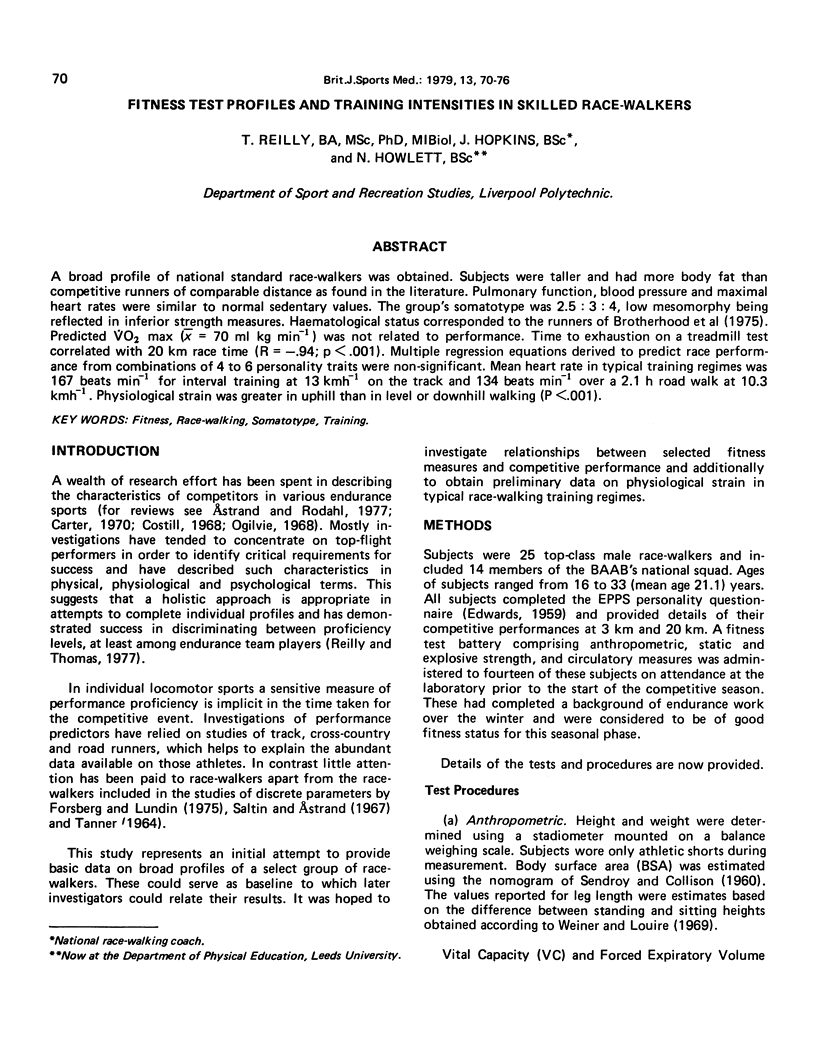
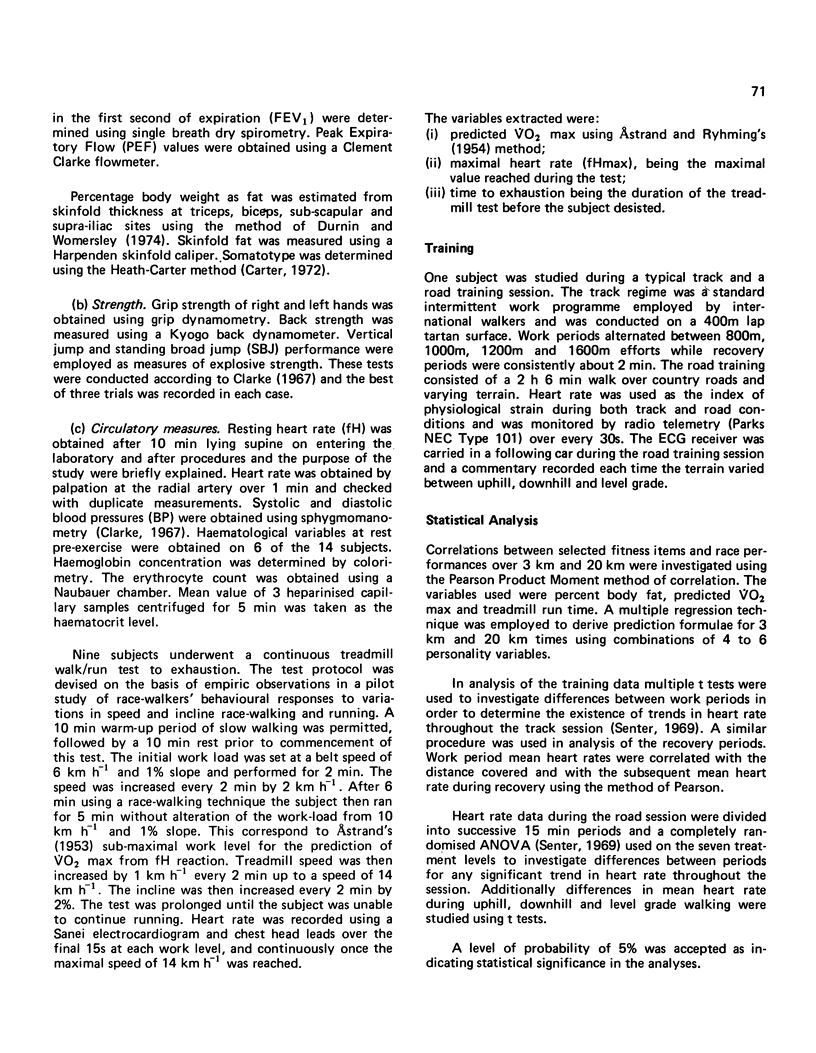
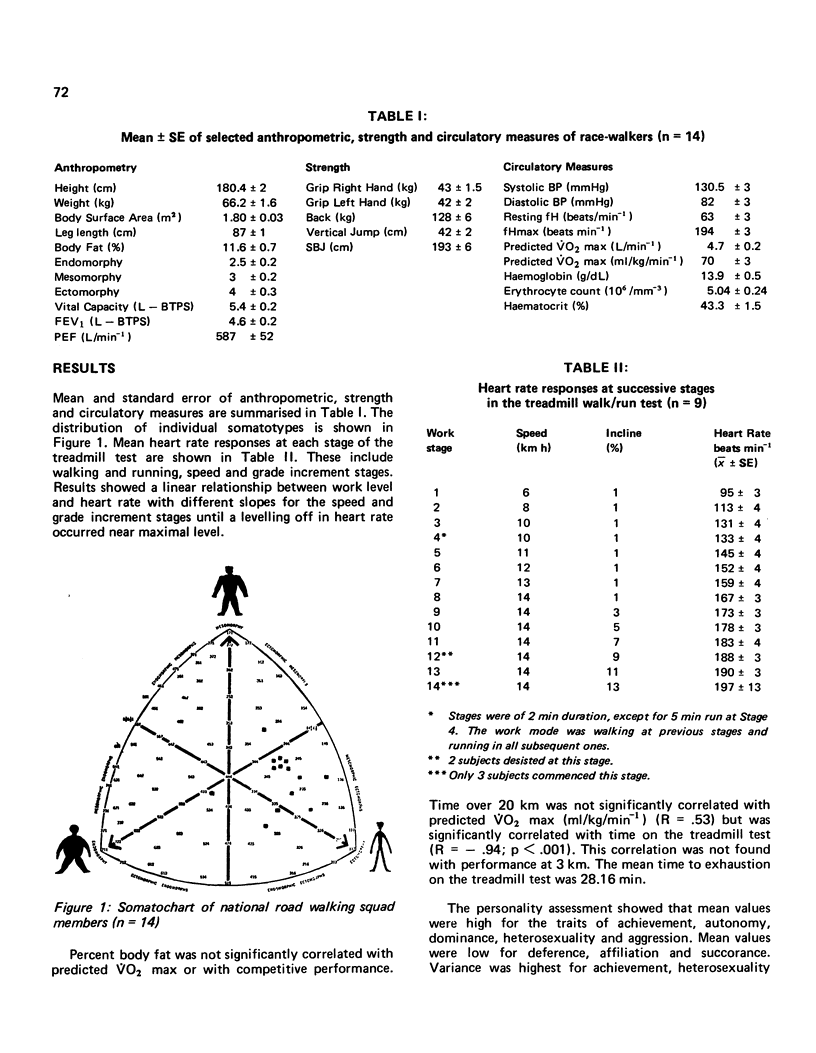
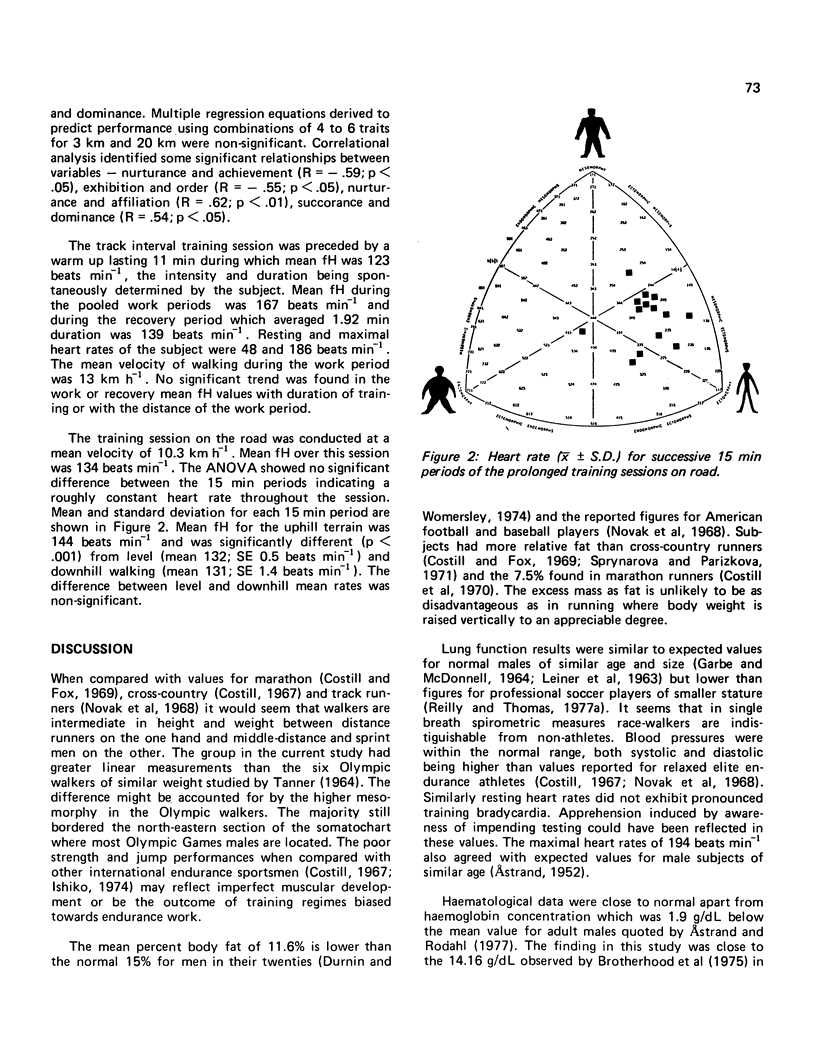
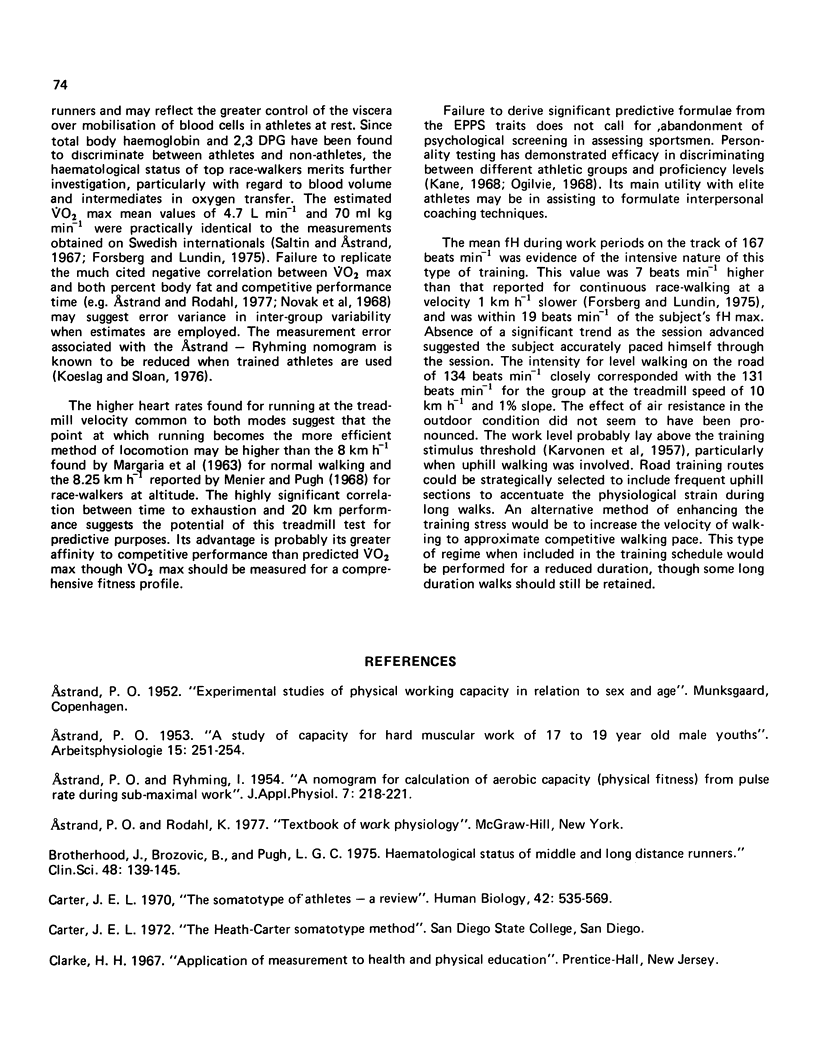
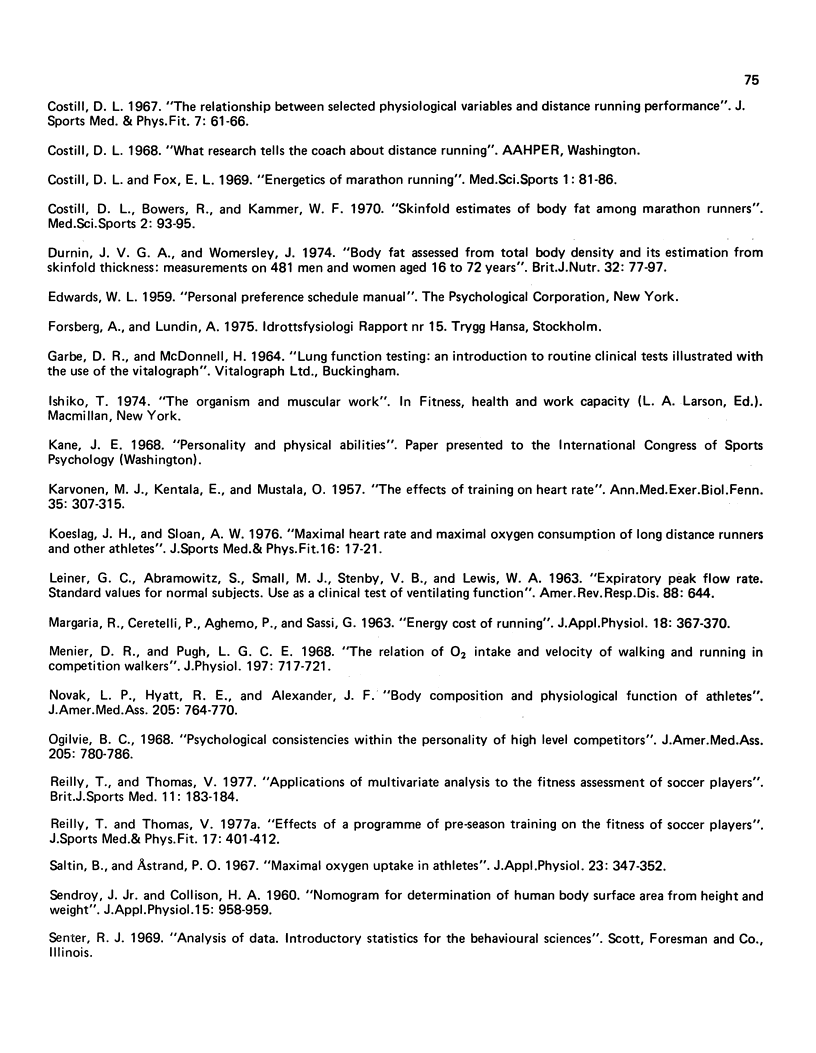

Selected References
These references are in PubMed. This may not be the complete list of references from this article.
- ASTRAND P. O. A study of capacity for hard muscular work of 17 to 19-year-old male youths. Arbeitsphysiologie. 1953;15(3):251–254. [PubMed] [Google Scholar]
- ASTRAND P. O., RYHMING I. A nomogram for calculation of aerobic capacity (physical fitness) from pulse rate during sub-maximal work. J Appl Physiol. 1954 Sep;7(2):218–221. doi: 10.1152/jappl.1954.7.2.218. [DOI] [PubMed] [Google Scholar]
- Brotherhood J., Brozović B., Pugh L. G. Haematological status of middle- and long-distance runners. Clin Sci Mol Med. 1975 Feb;48(2):139–145. doi: 10.1042/cs0480139. [DOI] [PubMed] [Google Scholar]
- Carter J. E. The somatotypes of athletes--a review. Hum Biol. 1970 Dec;42(4):535–569. [PubMed] [Google Scholar]
- Costill D. L., Bowers R., Kammer W. F. Skinfold estimates of body fat among marathon runners. Med Sci Sports. 1970 Summer;2(2):93–95. [PubMed] [Google Scholar]
- Costill D. L. The relationship between selected physiological variables and distance running performance. J Sports Med Phys Fitness. 1967 Jun;7(2):61–66. [PubMed] [Google Scholar]
- Durnin J. V., Womersley J. Body fat assessed from total body density and its estimation from skinfold thickness: measurements on 481 men and women aged from 16 to 72 years. Br J Nutr. 1974 Jul;32(1):77–97. doi: 10.1079/bjn19740060. [DOI] [PubMed] [Google Scholar]
- KARVONEN M. J., KENTALA E., MUSTALA O. The effects of training on heart rate; a longitudinal study. Ann Med Exp Biol Fenn. 1957;35(3):307–315. [PubMed] [Google Scholar]
- Koeslag J. H., Sloan A. W. Maximal heart rate and maximal oxygen consumption of long-distance runners and other athletes. J Sports Med Phys Fitness. 1976 Mar;16(1):17–21. [PubMed] [Google Scholar]
- LEINER G. C., ABRAMOWITZ S., SMALL M. J., STENBY V. B., LEWIS W. A. EXPIRATORY PEAK FLOW RATE. STANDARD VALUES FOR NORMAL SUBJECTS. USE AS A CLINICAL TEST OF VENTILATORY FUNCTION. Am Rev Respir Dis. 1963 Nov;88:644–651. doi: 10.1164/arrd.1963.88.5.644. [DOI] [PubMed] [Google Scholar]
- MARGARIA R., CERRETELLI P., AGHEMO P., SASSI G. Energy cost of running. J Appl Physiol. 1963 Mar;18:367–370. doi: 10.1152/jappl.1963.18.2.367. [DOI] [PubMed] [Google Scholar]
- Ogilvie B. C. Psychological consistencies within the personality of high-level competitors. JAMA. 1968 Sep 9;205(11):780–786. [PubMed] [Google Scholar]
- Reilly T., Thomas V. Applications of multivariate analysis to the fitness assessment of soccer players [proceedings]. Br J Sports Med. 1977 Dec;11(4):183–184. doi: 10.1136/bjsm.11.4.183. [DOI] [PMC free article] [PubMed] [Google Scholar]
- Reilly T., Thomas V. Effects of a programme of pre-season training on the fitness of soccer players. J Sports Med Phys Fitness. 1977 Dec;17(4):401–412. [PubMed] [Google Scholar]
- SENDROY J., Jr, COLLISON H. A. Nomogram for determination of human body surface area from height and weight. J Appl Physiol. 1960 Sep;15:958–959. doi: 10.1152/jappl.1960.15.5.958. [DOI] [PubMed] [Google Scholar]
- Sprynarová S., Parízková J. Functional capacity and body composition in top weight-lifters, swimmers, runners and skiers. Int Z Angew Physiol. 1971;29(2):184–194. [PubMed] [Google Scholar]


